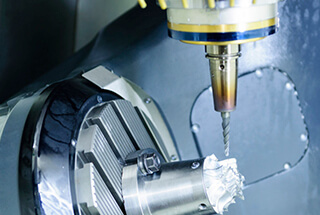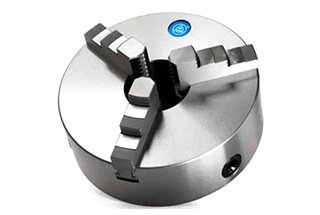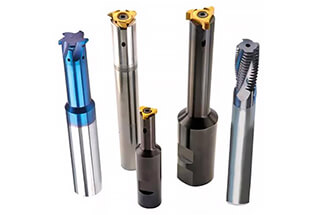Summary:
- Due to the relatively low strength and hardness, small plasticity, low tool wear, and high thermal conductivity of aluminum alloy, the cutting temperature is lower, making it easier to cut and a suitable material for high-speed cutting. However, the low melting point of aluminum alloy leads to increased plasticity at high temperatures and pressures, resulting in substantial friction at the cutting interface, which can cause tool adhesion. In particular, annealed aluminum alloys are difficult to obtain a low surface roughness.
- Compared to steel and brass, aluminum alloy has two distinct characteristics: the material is soft and less rigid, and its elastic modulus is low. These two factors significantly affect the machinability of aluminum alloy. Therefore, when machining aluminum alloy workpieces, it is necessary to clamp and support the workpiece adequately and keep the cutting tools sharp. Otherwise, the workpiece tends to move away from the cutting tool. Sometimes irregular grooves and shiny compression marks appear on the surface of the workpiece. One possibility is that the pressure of the cutting tool on the workpiece is not normal, and another possibility is that the cutting tool rubs gap-style on the surface of the workpiece when there is insufficient clamping or vibration occurs, resulting in compression and powdery cutting. Then, when the gap or elasticity disappears, the cutting tool bites into the surface of the workpiece and leaves grooves.
- To achieve a smooth surface finish on workpieces, it is best to use a combination of rough and finish cutting. This is because various qualified workpiece blanks tend to have some oxide layers that cause considerable wear on the cutting tools. If sharp, polished cutting tools are used for the final cutting process, the above requirements can be met.
- Aluminum alloy cutting properties are generally divided into two categories: Category 1 refers to industrial pure aluminum and annealed aluminum alloys with a hardness less than 80HB, while Category 2 refers to deformation aluminum alloys in quenched and aged states. The cutting process parameters for aluminum alloy depend on these categories.

Typical cutting parameters for high-speed steel and cemented carbide cutting tools
| Operation | Tool materials | Category of Machining | Cutting Speed (m/min) | Back Rake Angle (°) | End Relief Angle (°) | Feed Rate (mm/r) | Cutting Depth (mm) | Coolant |
| Rough turning. | High-speed steel. | 1 | 200-400 | 40433 | 30-40 | ≤1 | 40252 | no |
| 2 | 100-250 | 40400 | 20-30 | 0.2-0.5 | 40252 | no | ||
| Cemented carbide | 1 | 600-1200 | 40369 | 20-30 | 0.3-0.6 | 40252 | no | |
| 2 | 200-400 | 40369 | 40471 | 0.25-0.6 | 40252 | no | ||
| Finish turning. | High-speed steel. | 1 | 400-900 | 40400 | 40-50 | 0.05-0.3 | 0.3-2.5 | Cutting Fluid (Emulsion or Cutting Oil) |
| 2 | 200-500 | 40368 | 30-40 | 0.03-0.25 | 0.3-2.5 | |||
| Cemented carbide | 1 | ≤2400 | 40400 | 20-30 | ≤0.15 | 0.3-2.5 | Cutting Fluid (Emulsion or Cutting Oil) | |
| 2 | 250-700 | 40368 | 40471 | 0.05-0.1 | 0.3-2.5 |
Typical Cutting Parameters for Diamond Tooling
| Category of Machining | Milling Speed (m/min) | Feed rate (mm/r) | Cutting Depth for Long Chip Alloy (mm) | Cutting Depth for Short Chip Alloy (mm) |
| 1 | ≤3000 | 0.02-0.1 | 0.02-0.3 | 0.02-0.6 |
| 2 | 800-1400 | 0.02-0.1 | 0.02-0.3 | 0.02-0.6 |
Typical Milling Parameters for Aluminum Alloy
| Operation. | Tool material. | Category of Machining | Milling Speed (m/min) | Lead Angle (°) | Side Tilt Angle (°) | Feed rate (mm/r) | Milling Depth (mm) | Helix Angle (°) | Coolant |
| Rough milling | High-speed steel | 1 | 300-600 | 8 | 25 | 0.1-0.5 | 40229 | 30-40 | no |
| 2 | 150-400 | 6 | 20 | 0.1-0.5 | 40229 | ≤30 | Water-soluble coolant. | ||
| Cemented carbide | 1 | ≤2500 | 8 | 20 | 0.1-0.6 | 40229 | 30-40 | no | |
| 2 | 300-800 | 6 | 15 | 0.1-0.6 | 40229 | ≤30 | no | ||
| Finish milling | High-speed steel | 1 | ≤1500 | 12 | 30 | 0.03-0.1 | ≤0.5 | 30-40 | Water-soluble coolant. |
| 2 | 250-800 | 10 | 25 | 0.03-0.1 | ≤0.5 | ≤30 | Water-soluble coolant or oil. | ||
| Cemented carbide | 1 | ≤3000 | 12 | 25 | 0.03-0.1 | ≤0.5 | 30-40 | Water-soluble coolant. | |
| 2 | 500-1500 | 10 | 20 | 0.03-0.1 | ≤0.5 | ≤30 | Water-soluble coolant or oil. |
Typical parameters for twist drilling in aluminum alloy
| Tool material | Cutting type | Milling speed (m/min) | Point angle (°) | Helix angle (°) | Feed rate (mm/r) | Secondary relief angle (°) | Coolant |
| High-speed steel | 1 | 100-120 | 140 | 45-30 | 0.02-0.5 | 17-15 | Water-soluble coolant |
| 2 | 80-100 | 120 | 35-20 | 0.02-0.5 | 15 | Water-soluble coolant | |
| Cemented carbide | 1 | 200-300 | 130 | 25-15 | 0.06-0.3 | 12 | No coolant or water-soluble coolant |
| 2 | 100-200 | 120 | 40466 | 0.06-0.3 | 12 | No coolant or water-soluble coolant | |
| Note | Low speed is recommended for drilling small holes. | When drilling on thin plates, it is recommended to increase the point angle or use a drill with a positive rake angle. | When drilling small holes, it is recommended to use a drill with a small helix angle. | The feed rate for drilling small holes should be small. | When grinding the secondary relief angle, it is important to select the appropriate angle. | It is better to use a water-soluble coolant | |
Typical drilling parameters before tapping threads in aluminum alloy
| Standard thread | M3 | M3.5 | M4 | M4.5 | M5 | M6 | M8 | M10 | M12 | M14 | M16 |
| Hole diameter (mm) | 2.7 | 3.75 | 3.6 | 4.1 | 4.6 | 5.5 | 7.3 | 9.1 | 11 | 12.8 | 14.8 |
Typical boring parameters for aluminum alloy
| Tool | Tool material | Milling speed (m/min) | Feed rate (mm/r) | Point angle (°) | Helix angle (°) | Secondary relief angle (°) | Coolant |
| Replaceable boring cutter | High-speed steel. | 25-40 | 0.2-0.3 | 140 | 30-20 | 8 | Water-soluble coolant |
| Cemented carbide | 60-100 | 0.1-0.3 | 120 | 20-15 | 6 | Water-soluble coolant | |
| Trial boring cutter | High-speed steel | 25-40 | 0.2-0.3 | – | 30-20 | 8 | Water-soluble coolant |
| Cemented carbide | 60-100 | 0.1-0.3 | 20-15 | 6 | Water-soluble coolant | ||
| Expanding boring cutter | High-speed steel | 20-30 | 0.3-0.6 | 60-120 | – | 6 | Water-soluble coolant |
| Cemented carbide | 50-70 | 0.2-0.5 | 60-120 | 6 | Water-soluble coolant | ||
| Boring bar | High-speed steel | 25-40 | 0.05-0.6 | – | 30-20 | 12 | No coolant or water-soluble coolant |
| Cemented carbide | 60-100 | 0.05-0.6 | 20-15 | 10 | No coolant or water-soluble coolant |
Typical reaming parameters for aluminum alloy
| Tool | Tool material. | Chamfer (°). | Lead angle (°). | Reaming speed (m/min). | The feed rate (mm/r) for the reamed hole diameter (mm) is as follows: | ||||||
|---|---|---|---|---|---|---|---|---|---|---|---|
| ≤10 | >10-25 | >25-40 | >40 | ||||||||
| Hand reamer. | High-speed steel. | 45 | 40241 | / | / | / | / | / | |||
| Cemented carbide. | 45 | 40241 | / | / | / | / | / | ||||
| Hob. | High-speed steel. | 30 | 0 | 40471 | 0.1-0.2 | 0.2-0.4 | 0.3-0.5 | 0.4-0.8 | |||
| Cemented carbide. | 30 | 0 | 20-50 | 0.2-0.3 | 0.3-0.5 | 0.4-0.7 | 0.5-1.0 | ||||
| Deviation. | The allowable deviation (mm/r) of the reamed hole diameter (mm) is as follows: | ||||||||||
| Insufficient diameter of pre-drilled hole. | High-speed steel. | ≤10 | >10-25 | >25-40 | >40 | ||||||
| Cemented carbide. | ≤0.2 | 0.1-0.3 | 0.1-0.3 | 0.2-0.5 | |||||||
| 0.06-0.1 | 0.1-0.2 | 0.1-0.3 | 0.2-0.4 | ||||||||
Note: The coolant used is a mixture of kerosene-turpentine oil (5:4), or mineral oil with a viscosity of about 33°E, or high-quality oil. The quality of dry reamed holes is not very high.


